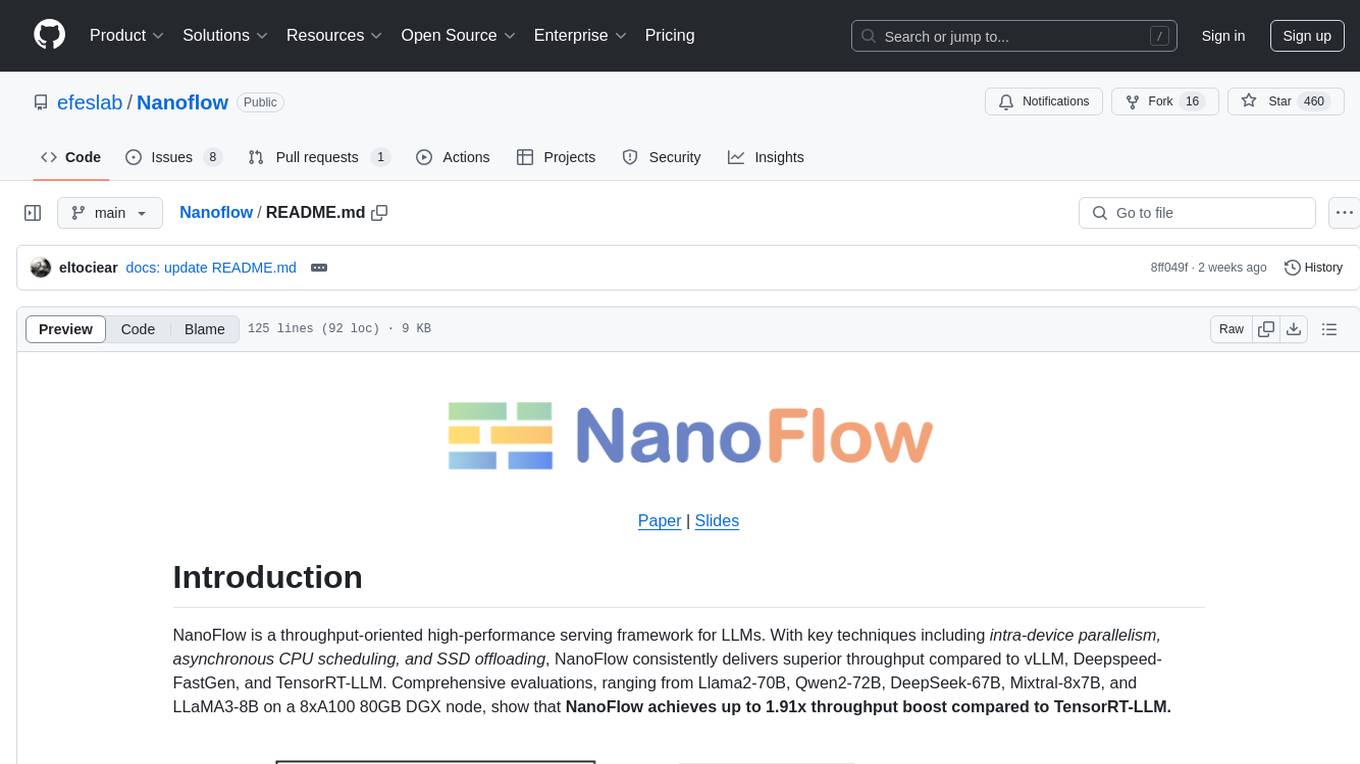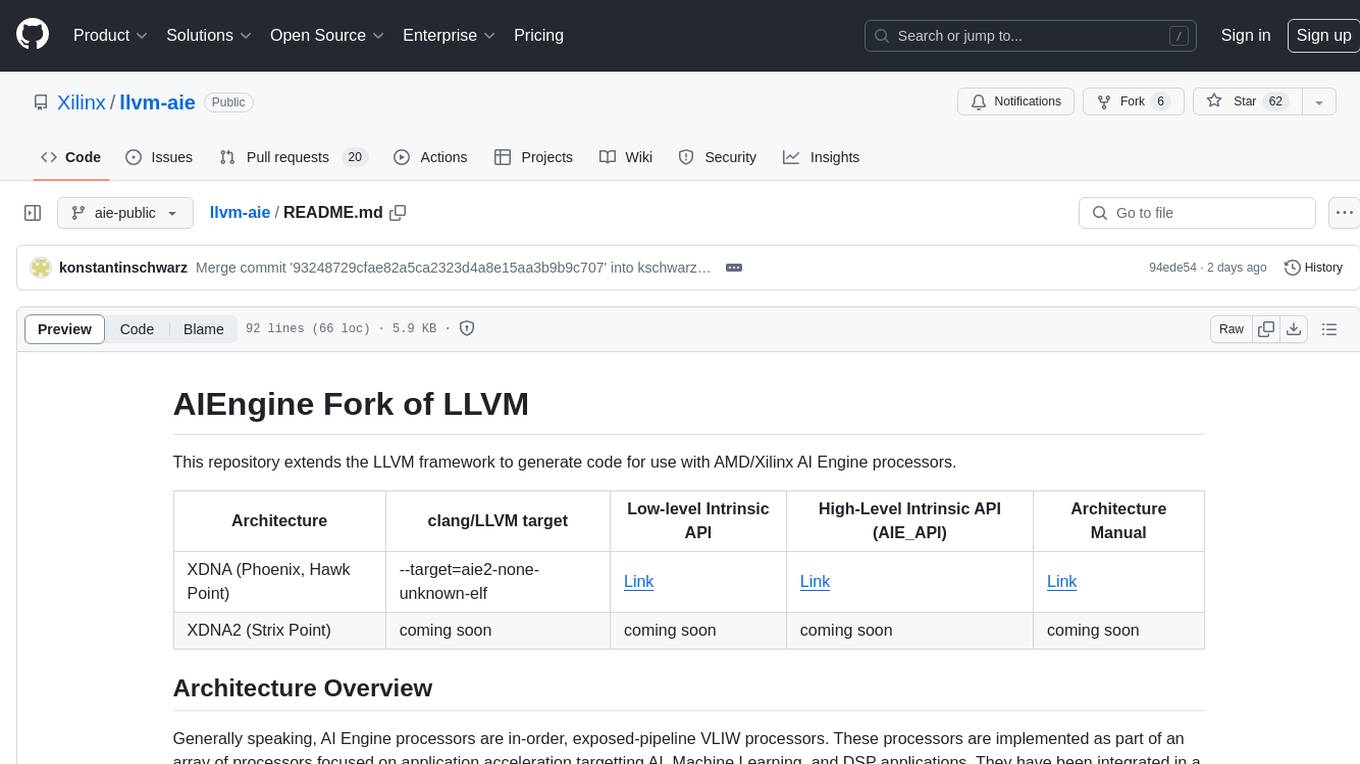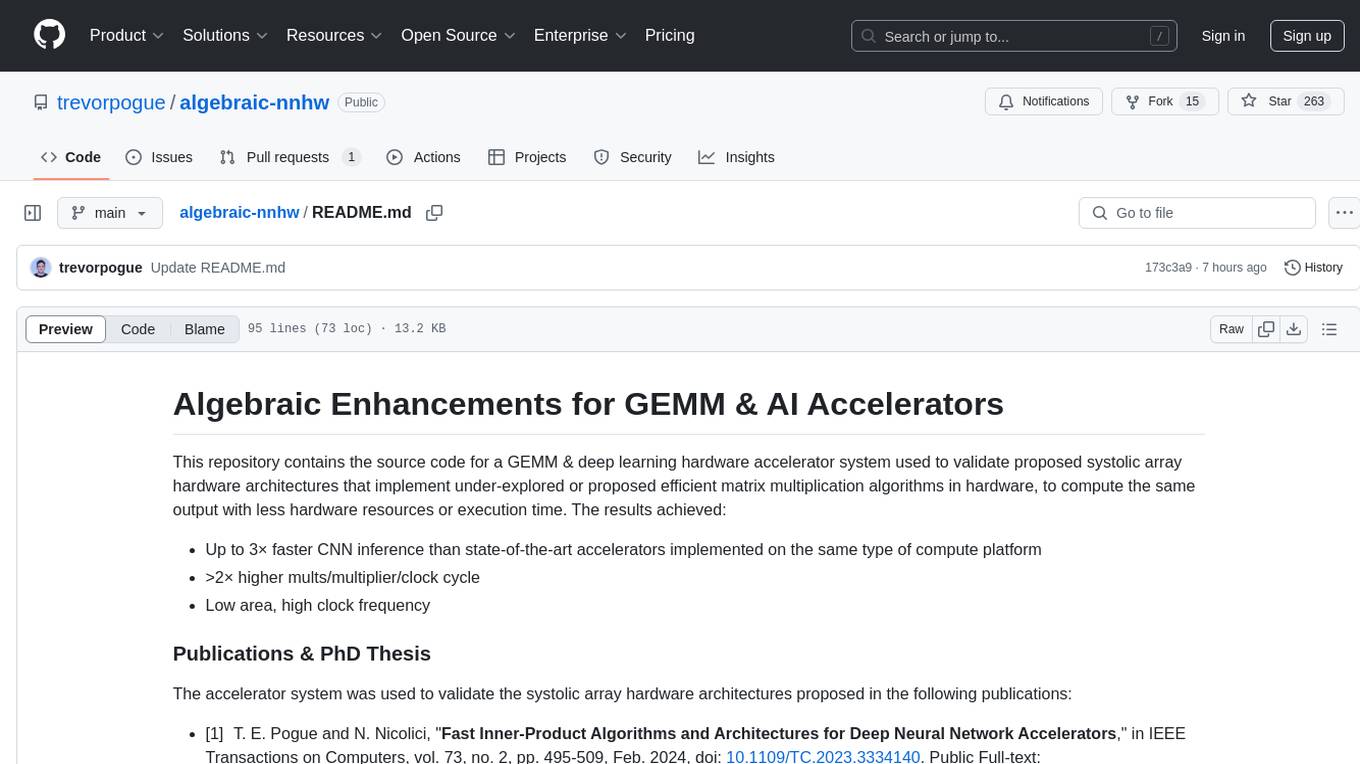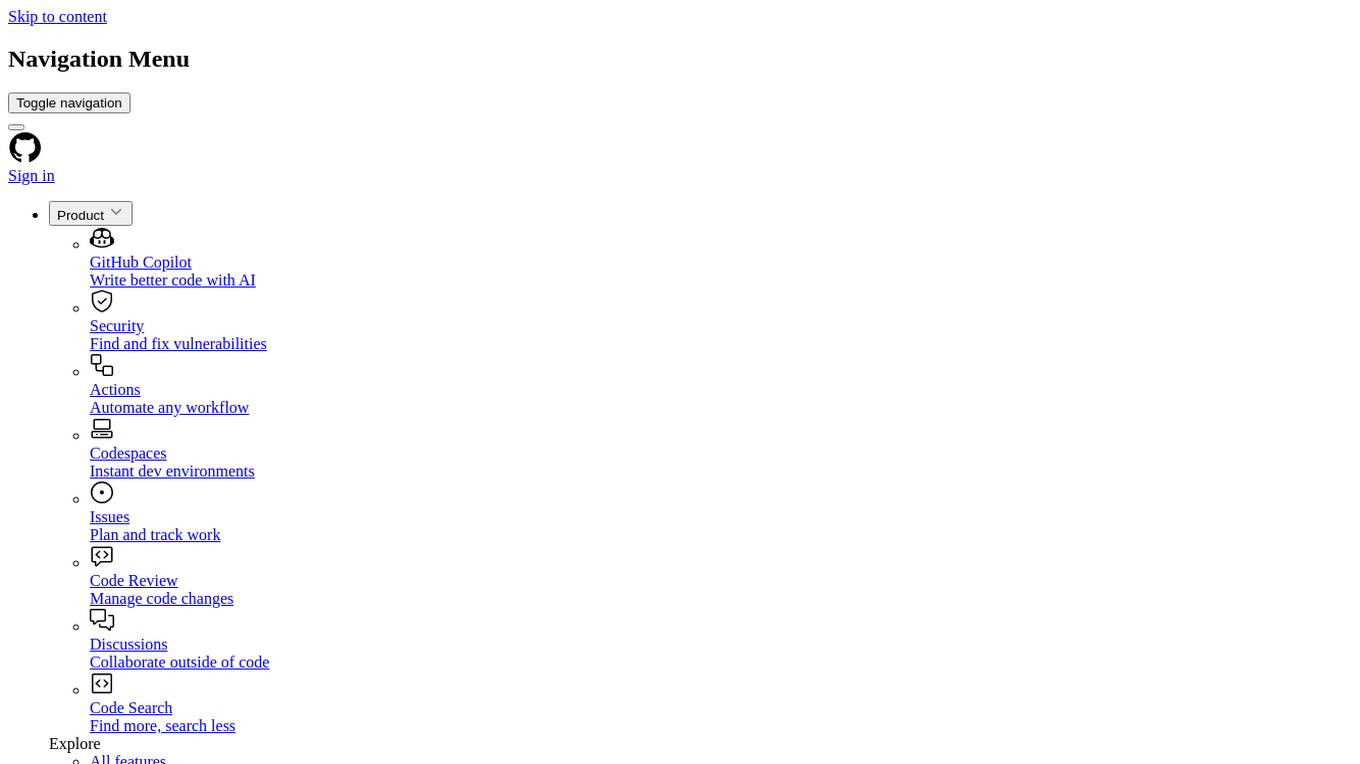
Nanoflow
A throughput-oriented high-performance serving framework for LLMs
Stars: 483

NanoFlow is a throughput-oriented high-performance serving framework for Large Language Models (LLMs) that consistently delivers superior throughput compared to other frameworks by utilizing key techniques such as intra-device parallelism, asynchronous CPU scheduling, and SSD offloading. The framework proposes nano-batching to schedule compute-, memory-, and network-bound operations for simultaneous execution, leading to increased resource utilization. NanoFlow also adopts an asynchronous control flow to optimize CPU overhead and eagerly offloads KV-Cache to SSDs for multi-round conversations. The open-source codebase integrates state-of-the-art kernel libraries and provides necessary scripts for environment setup and experiment reproduction.
README:
NanoFlow is a throughput-oriented high-performance serving framework for LLMs. NanoFlow consistently delivers superior throughput compared to vLLM, Deepspeed-FastGen, and TensorRT-LLM. NanoFlow achieves up to 1.91x throughput boost compared to TensorRT-LLM. The key features of NanoFlow include:
- Intra-device parallelism: Maximizes hardware utilization by exploiting nano-batching and execution unit scheduling to overlap different resource demands inside a single device.
- Asynchronous CPU scheduling: Achieves highly efficient CPU scheduling by adopting asynchronous control flow for GPU execution, CPU batch formation and KV-cache management.
- [2024/09] 🚀 Nanoflow now supports Llama2 70B, Llama3 70B, Llama3.1 70B, Llama3 8B, Llama3.1 8B and Qwen2 72B models. We also released experiment scripts to reproduce the evaluation results.
The key insight behinds NanoFlow is that traditional pipeline design of existing frameworks under-utilizes hardware resources due to the sequential execution of operations. Therefore, NanoFlow proposes intra-device parallelism (as shown in the following gif), which use nano-batches to schedule the compute-, memory-, network-bound operations for simultaneous execution. Such overlapping leaves compute-bound operations on the critical path and boost the resource utilization.
Overview of NanoFlow's key components
Illustration of intra-device parallelism
With highly utilized GPU, the overhead of CPU, which consists of KV-cache management, batch formation, and retired requests selection, takes significant part ($>10$%) of inference time. Therefore, NanoFlow adopts an asyncronous control flow as shown in the following figure. At any iteration $i$, NanoFlow makes batching decisions and allocates the KV-cache entries for the next iteration before the end of the current iteration. NanoFlow directly launches iteration $i + 1$ without detecting the end-of-sequence (EOS) tokens generated in iteration $i$ and retires completed requests at iteration $i+2$.
Explanation of asyncronous control flow scheduling
To avoid recomputation and reuse the KV-cache from multi-round conversations, NanoFlow eagerly offloads the KV-cache of finished requests to SSDs. In one iteration, NanoFlow selects the KV-cache of the retired requests and copies them to the host in parallel to the on-the-fly inference operations, via a layer-by-layer manner. Our calculation shows that only 5GB/s are needed for the offloading bandwidth of serving LLaMA2-70B, while a single SSD can reach 3GB/s.
With all mentioned techniques implemented, we now open-source NanoFlow of a Cpp-based backend and a Python-based demo frontend in ~4K lines. NanoFlow integrates state-of-the-art kernel libraries including CUTLASS for GEMM, FlashInfer for Attention, and MSCCL++ for Network. This codebase also contains necessary scripts for environment setup and experiment reproduction.
We list some of the primary benchmarks. Please check our paper for more details. We evaluate on A100 80GB SXM and choose vLLM v0.5.3, Deepspeed-FastGen v0.2.3, and TensorRT-LLM v0.8.0 as baselines. Note that all frameworks turn off specific optimizations like quantization, speculative decoding, prefix cache, etc..
We conduct offline througput in two settings: practical workloads from collected traces (Splitwise, LMSYS-Chat-1M, ShareGPT), and constant input/output length. NanoFlow consistently surpasses all the baselines.
Offline throughput benchmarks
We test the normalized latency (which is the end-to-end request latency divided by number of output tokens) with the three real-world traces and set different request rate (incoming requests per second). NanoFlow is able to sustain a higher request rate with low latency compared to baselines among all the datasets.
Online latency benchmarks
We ported NanoFlow to 5 representative models to showcase its flexibility. We evaluate the offline throughput of NanoFlow (tokens per second per GPU) on these LLMs with constant length of input 1024 and output 512.
Offline throughput of NanoFlow on different models
The increasing usage of Large Language Models (LLMs) has resulted in a surging demand for planet-scale serving systems, where tens of thousands of GPUs continuously serve hundreds of millions of users. Consequently, throughput (under reasonable latency constraints) has emerged as a key metric that determines serving systems’ performance. To boost throughput, various methods of inter-device parallelism (e.g., data, tensor, pipeline) have been explored. However, existing methods do not consider overlapping the utilization of different resources within a single device, leading to underutilization and sub-optimal performance.
We propose NanoFlow, a novel serving framework that exploits intra-device parallelism, which overlaps the usage of resources including compute, memory, and network within a single device through operation co-scheduling. To exploit intra-device parallelism, NanoFlow introduces two key innovations: First, NanoFlow proposes nano-batching to split requests at the granularity of operations, which breaks the dependency of sequential operations in LLM inference and enables overlapping them; then, to get benefit from overlapping, NanoFlow uses a device-level pipeline with execution unit scheduling, which partitions the device’s functional units and simultaneously executes different operations in each unit. NanoFlow automates the pipeline setup using a parameter search algorithm, which enables easily porting NanoFlow to work with different models. We implement NanoFlow on NVIDIA GPUs and evaluate end-to-end serving throughput on several popular models such as LLaMA-2-70B, Mixtral 8×7B, LLaMA-3-8B, etc. We show that NanoFlow achieves 68.5% of optimal throughput. With practical workloads, NanoFlow provides 1.91× throughput boost compared to state-of-the-art serving systems achieving 59% to 72% of optimal throughput across ported models.
mkdir -p ~/framework-test
docker run --gpus all --net=host --privileged -v /dev/shm:/dev/shm --name nanoflow -v ~/framework-test:/code -it nvcr.io/nvidia/nvhpc:23.11-devel-cuda_multi-ubuntu22.04If using Runpod, we recommand using pytorch template 2.2.0.
git clone https://github.com/efeslab/Nanoflow.git
cd Nanoflow
chmod +x ./installAnaconda.sh
./installAnaconda.sh
# restart the terminalyes | ./setup.sh./serve.sh./perf.shResult figures can be found in Nanoflow/pipeline/eval.
If you use NanoFlow for your research, please cite our paper:
@misc{zhu2024nanoflowoptimallargelanguage,
title={NanoFlow: Towards Optimal Large Language Model Serving Throughput},
author={Kan Zhu and Yilong Zhao and Liangyu Zhao and Gefei Zuo and Yile Gu and Dedong Xie and Yufei Gao and Qinyu Xu and Tian Tang and Zihao Ye and Keisuke Kamahori and Chien-Yu Lin and Stephanie Wang and Arvind Krishnamurthy and Baris Kasikci},
year={2024},
eprint={2408.12757},
archivePrefix={arXiv},
primaryClass={cs.DC},
url={https://arxiv.org/abs/2408.12757},
}NanoFlow is inspired by and reuses code from the following projects: CUTLASS, FlashInfer, MSCCL++, and Punica. Development of NanoFlow is made easier thanks to these tools: GoogleTest, NVBench, and spdlog. We thank Siqin Chen for her help in the design of NanoFlow logo.
For Tasks:
Click tags to check more tools for each tasksFor Jobs:
Alternative AI tools for Nanoflow
Similar Open Source Tools

Nanoflow
NanoFlow is a throughput-oriented high-performance serving framework for Large Language Models (LLMs) that consistently delivers superior throughput compared to other frameworks by utilizing key techniques such as intra-device parallelism, asynchronous CPU scheduling, and SSD offloading. The framework proposes nano-batching to schedule compute-, memory-, and network-bound operations for simultaneous execution, leading to increased resource utilization. NanoFlow also adopts an asynchronous control flow to optimize CPU overhead and eagerly offloads KV-Cache to SSDs for multi-round conversations. The open-source codebase integrates state-of-the-art kernel libraries and provides necessary scripts for environment setup and experiment reproduction.

llm-d
LLM-D is a machine learning model for sentiment analysis. It is designed to classify text data into positive, negative, or neutral sentiment categories. The model is trained on a large dataset of labeled text samples and uses natural language processing techniques to analyze and predict sentiment in new text inputs. LLM-D is a powerful tool for businesses and researchers looking to understand customer feedback, social media sentiment, and other text data sources. It can be easily integrated into existing applications or used as a standalone tool for sentiment analysis tasks.

aihwkit
The IBM Analog Hardware Acceleration Kit is an open-source Python toolkit for exploring and using the capabilities of in-memory computing devices in the context of artificial intelligence. It consists of two main components: Pytorch integration and Analog devices simulator. The Pytorch integration provides a series of primitives and features that allow using the toolkit within PyTorch, including analog neural network modules, analog training using torch training workflow, and analog inference using torch inference workflow. The Analog devices simulator is a high-performant (CUDA-capable) C++ simulator that allows for simulating a wide range of analog devices and crossbar configurations by using abstract functional models of material characteristics with adjustable parameters. Along with the two main components, the toolkit includes other functionalities such as a library of device presets, a module for executing high-level use cases, a utility to automatically convert a downloaded model to its equivalent Analog model, and integration with the AIHW Composer platform. The toolkit is currently in beta and under active development, and users are advised to be mindful of potential issues and keep an eye for improvements, new features, and bug fixes in upcoming versions.

llvm-aie
This repository extends the LLVM framework to generate code for use with AMD/Xilinx AI Engine processors. AI Engine processors are in-order, exposed-pipeline VLIW processors focused on application acceleration for AI, Machine Learning, and DSP applications. The repository adds LLVM support for specific features like non-power of 2 pointers, operand latencies, resource conflicts, negative operand latencies, slot assignment, relocations, code alignment restrictions, and register allocation. It includes support for Clang, LLD, binutils, Compiler-RT, and LLVM-LIBC.

llumnix
Llumnix is a cross-instance request scheduling layer built on top of LLM inference engines such as vLLM, providing optimized multi-instance serving performance with low latency, reduced time-to-first-token (TTFT) and queuing delays, reduced time-between-tokens (TBT) and preemption stalls, and high throughput. It achieves this through dynamic, fine-grained, KV-cache-aware scheduling, continuous rescheduling across instances, KV cache migration mechanism, and seamless integration with existing multi-instance deployment platforms. Llumnix is easy to use, fault-tolerant, elastic, and extensible to more inference engines and scheduling policies.

long-context-attention
Long-Context-Attention (YunChang) is a unified sequence parallel approach that combines the strengths of DeepSpeed-Ulysses-Attention and Ring-Attention to provide a versatile and high-performance solution for long context LLM model training and inference. It addresses the limitations of both methods by offering no limitation on the number of heads, compatibility with advanced parallel strategies, and enhanced performance benchmarks. The tool is verified in Megatron-LM and offers best practices for 4D parallelism, making it suitable for various attention mechanisms and parallel computing advancements.

aphrodite-engine
Aphrodite is an inference engine optimized for serving HuggingFace-compatible models at scale. It leverages vLLM's Paged Attention technology to deliver high-performance model inference for multiple concurrent users. The engine supports continuous batching, efficient key/value management, optimized CUDA kernels, quantization support, distributed inference, and modern samplers. It can be easily installed and launched, with Docker support for deployment. Aphrodite requires Linux or Windows OS, Python 3.8 to 3.12, and CUDA >= 11. It is designed to utilize 90% of GPU VRAM but offers options to limit memory usage. Contributors are welcome to enhance the engine.

algebraic-nnhw
This repository contains the source code for a GEMM & deep learning hardware accelerator system used to validate proposed systolic array hardware architectures implementing efficient matrix multiplication algorithms to increase performance-per-area limits of GEMM & AI accelerators. Achieved results include up to 3× faster CNN inference, >2× higher mults/multiplier/clock cycle, and low area with high clock frequency. The system is specialized for inference of non-sparse DNN models with fixed-point/quantized inputs, fully accelerating all DNN layers in hardware, and highly optimizing GEMM acceleration.

WeatherGFT
WeatherGFT is a physics-AI hybrid model designed to generalize weather forecasts to finer-grained temporal scales beyond the training dataset. It incorporates physical partial differential equations (PDEs) into neural networks to simulate fine-grained physical evolution and correct biases. The model achieves state-of-the-art performance in forecasting tasks at different time scales, from nowcasting to medium-range forecasts, by utilizing a lead time-aware training framework and a carefully designed PDE kernel. WeatherGFT bridges the gap between nowcast and medium-range forecast by extending forecasting abilities to predict accurately at a 30-minute time scale.

awesome-transformer-nlp
This repository contains a hand-curated list of great machine (deep) learning resources for Natural Language Processing (NLP) with a focus on Generative Pre-trained Transformer (GPT), Bidirectional Encoder Representations from Transformers (BERT), attention mechanism, Transformer architectures/networks, Chatbot, and transfer learning in NLP.

sample-apps
Vespa is an open-source search and AI engine that provides a unified platform for building and deploying search and AI applications. Vespa sample applications showcase various use cases and features of Vespa, including basic search, recommendation, semantic search, image search, text ranking, e-commerce search, question answering, search-as-you-type, and ML inference serving.

aligner
Aligner is a model-agnostic alignment tool that learns correctional residuals between preferred and dispreferred answers using a small model. It can be directly applied to various open-source and API-based models with only one-off training, suitable for rapid iteration and improving model performance. Aligner has shown significant improvements in helpfulness, harmlessness, and honesty dimensions across different large language models.

agentUniverse
agentUniverse is a multi-agent framework based on large language models, providing flexible capabilities for building individual agents. It focuses on collaborative pattern components to solve problems in various fields and integrates domain experience. The framework supports LLM model integration and offers various pattern components like PEER and DOE. Users can easily configure models and set up agents for tasks. agentUniverse aims to assist developers and enterprises in constructing domain-expert-level intelligent agents for seamless collaboration.

agentUniverse
agentUniverse is a multi-agent framework based on large language models, providing flexible capabilities for building individual agents. It focuses on multi-agent collaborative patterns, integrating domain experience to help agents solve problems in various fields. The framework includes pattern components like PEER and DOE for event interpretation, industry analysis, and financial report generation. It offers features for agent construction, multi-agent collaboration, and domain expertise integration, aiming to create intelligent applications with professional know-how.

NeMo
NeMo Framework is a generative AI framework built for researchers and pytorch developers working on large language models (LLMs), multimodal models (MM), automatic speech recognition (ASR), and text-to-speech synthesis (TTS). The primary objective of NeMo is to provide a scalable framework for researchers and developers from industry and academia to more easily implement and design new generative AI models by being able to leverage existing code and pretrained models.

aligner
Aligner is a model-agnostic alignment tool designed to efficiently correct responses from large language models. It redistributes initial answers to align with human intentions, improving performance across various LLMs. The tool can be applied with minimal training, enhancing upstream models and reducing hallucination. Aligner's 'copy and correct' method preserves the base structure while enhancing responses. It achieves significant performance improvements in helpfulness, harmlessness, and honesty dimensions, with notable success in boosting Win Rates on evaluation leaderboards.
For similar tasks

Nanoflow
NanoFlow is a throughput-oriented high-performance serving framework for Large Language Models (LLMs) that consistently delivers superior throughput compared to other frameworks by utilizing key techniques such as intra-device parallelism, asynchronous CPU scheduling, and SSD offloading. The framework proposes nano-batching to schedule compute-, memory-, and network-bound operations for simultaneous execution, leading to increased resource utilization. NanoFlow also adopts an asynchronous control flow to optimize CPU overhead and eagerly offloads KV-Cache to SSDs for multi-round conversations. The open-source codebase integrates state-of-the-art kernel libraries and provides necessary scripts for environment setup and experiment reproduction.
For similar jobs

weave
Weave is a toolkit for developing Generative AI applications, built by Weights & Biases. With Weave, you can log and debug language model inputs, outputs, and traces; build rigorous, apples-to-apples evaluations for language model use cases; and organize all the information generated across the LLM workflow, from experimentation to evaluations to production. Weave aims to bring rigor, best-practices, and composability to the inherently experimental process of developing Generative AI software, without introducing cognitive overhead.

LLMStack
LLMStack is a no-code platform for building generative AI agents, workflows, and chatbots. It allows users to connect their own data, internal tools, and GPT-powered models without any coding experience. LLMStack can be deployed to the cloud or on-premise and can be accessed via HTTP API or triggered from Slack or Discord.

VisionCraft
The VisionCraft API is a free API for using over 100 different AI models. From images to sound.

kaito
Kaito is an operator that automates the AI/ML inference model deployment in a Kubernetes cluster. It manages large model files using container images, avoids tuning deployment parameters to fit GPU hardware by providing preset configurations, auto-provisions GPU nodes based on model requirements, and hosts large model images in the public Microsoft Container Registry (MCR) if the license allows. Using Kaito, the workflow of onboarding large AI inference models in Kubernetes is largely simplified.

PyRIT
PyRIT is an open access automation framework designed to empower security professionals and ML engineers to red team foundation models and their applications. It automates AI Red Teaming tasks to allow operators to focus on more complicated and time-consuming tasks and can also identify security harms such as misuse (e.g., malware generation, jailbreaking), and privacy harms (e.g., identity theft). The goal is to allow researchers to have a baseline of how well their model and entire inference pipeline is doing against different harm categories and to be able to compare that baseline to future iterations of their model. This allows them to have empirical data on how well their model is doing today, and detect any degradation of performance based on future improvements.

tabby
Tabby is a self-hosted AI coding assistant, offering an open-source and on-premises alternative to GitHub Copilot. It boasts several key features: * Self-contained, with no need for a DBMS or cloud service. * OpenAPI interface, easy to integrate with existing infrastructure (e.g Cloud IDE). * Supports consumer-grade GPUs.

spear
SPEAR (Simulator for Photorealistic Embodied AI Research) is a powerful tool for training embodied agents. It features 300 unique virtual indoor environments with 2,566 unique rooms and 17,234 unique objects that can be manipulated individually. Each environment is designed by a professional artist and features detailed geometry, photorealistic materials, and a unique floor plan and object layout. SPEAR is implemented as Unreal Engine assets and provides an OpenAI Gym interface for interacting with the environments via Python.

Magick
Magick is a groundbreaking visual AIDE (Artificial Intelligence Development Environment) for no-code data pipelines and multimodal agents. Magick can connect to other services and comes with nodes and templates well-suited for intelligent agents, chatbots, complex reasoning systems and realistic characters.








